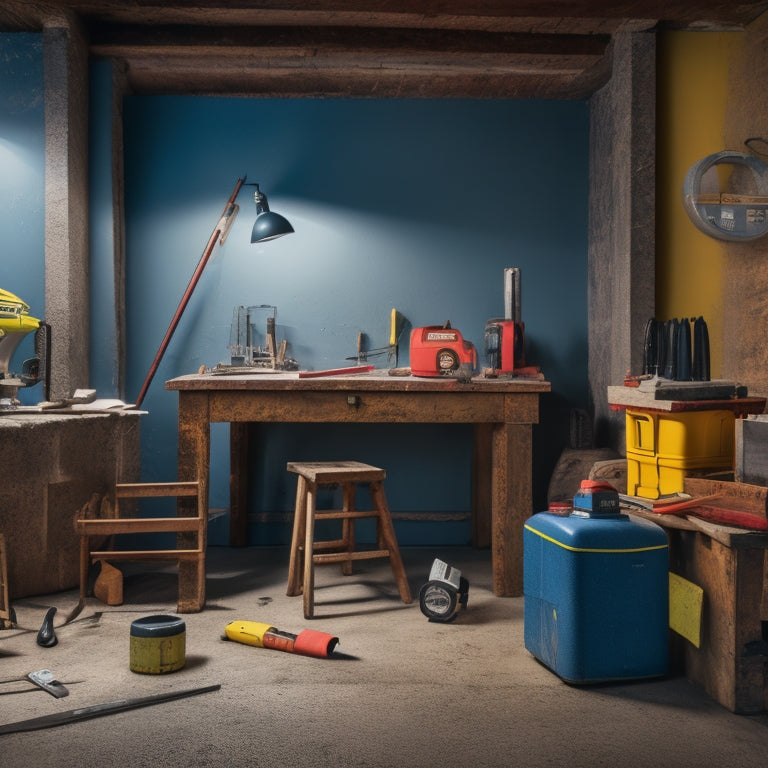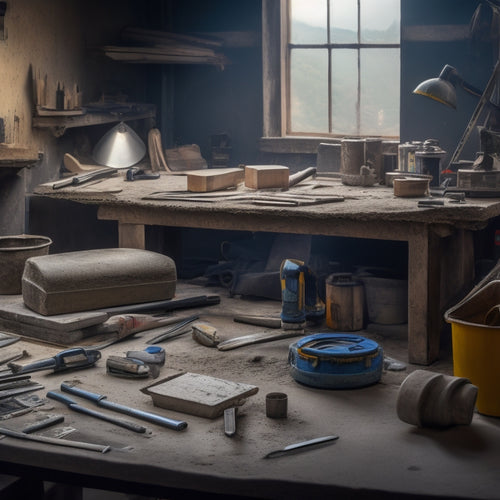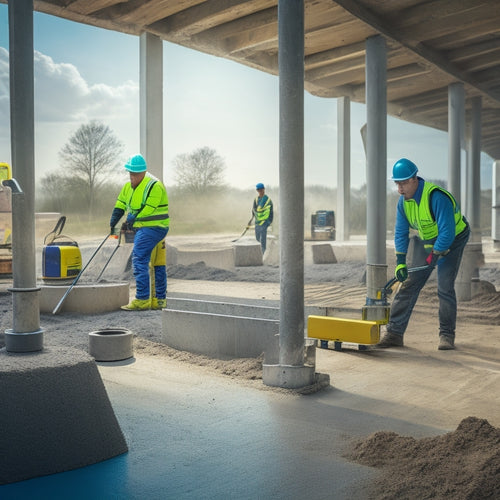
7 Must-Have Tools for Leveling Concrete Block Walls
Share
You'll need a specific set of tools to level concrete block walls accurately. Start with a spirit level and straight edge for confirming plumb and level measurements. A laser level and detector provides a highly accurate reference plane, while a precision measuring tape tool helps you measure wall thickness and record block dimensions. A concrete block plane tool is essential for precision-planing individual blocks. Additionally, you'll need a wedge and shim placement kit for precise alignment, a block cutter and splitter tool for cutting blocks to size, and wall alignment and straightening techniques to guarantee accuracy. Now, get ready to master the art of leveling concrete block walls with these must-have tools and discover the nuances of each in your project.
Key Takeaways
• A spirit level and straight edge are essential for confirming plumb and level measurements in concrete block walls.
• A laser level and detector provide a highly accurate and efficient level reference plane for construction sites.
• Precise measurement of each block's dimensions is crucial for wall stability and ensuring compliance with project specifications.
• A wedge and shim placement kit is necessary for precise alignment and leveling of concrete block walls.
• A block cutter and splitter tool is required for cutting and dividing concrete blocks to required sizes, ensuring a snug fit and minimizing waste.
Spirit Level and Straight Edge
When leveling concrete block walls, you rely on a spirit level and straight edge to confirm accurate plumb and level measurements. These tools are essential for guaranteeing your walls are perfectly vertical and horizontal.
To get the most out of your spirit level, master spirit level techniques such as checking for levelness in multiple directions and using the level on a stable surface. Regularly clean and inspect your spirit level to verify its accuracy isn't compromised by dirt or damage.
Your straight edge is equally important, serving as a reference point for your spirit level and a guide for marking straight lines. Straight edge maintenance is critical, as a warped or damaged edge can throw off your entire project.
Store your straight edge in a protective case when not in use, and regularly inspect it for signs of wear or damage.
Laser Level and Detector
You can further refine your leveling process by incorporating a laser level and detector, which provide a highly accurate and efficient way to establish a level reference plane across your concrete block wall construction site.
This powerful combo enables you to create a precise leveling benchmark, guaranteeing that your concrete blocks are perfectly aligned and plumb.
To get the most out of your laser level, it's essential to employ proper laser calibration techniques to maintain accuracy and reliability. This involves checking the device's leveling vials, adjusting the beam's angle, and verifying the laser's self-leveling mechanism.
When it comes to the detector, you'll want to optimize its range to cover the entire construction site. This can be achieved by adjusting the detector's sensitivity, fine-tuning its alignment with the laser beam, and using extension poles or tripods to increase its range.
By doing so, you'll be able to detect even the slightest deviations from the level reference plane, allowing you to make precise adjustments and achieve a perfectly level concrete block wall.
With a laser level and detector, you'll be able to work faster, smarter, and with unparalleled accuracy.
Concrete Block Plane Tool
A concrete block plane tool is a versatile, handheld device that enables you to precision-plane individual concrete blocks, ensuring a snug, uniform fit and a level surface. This tool is essential for concrete block maintenance, as it allows you to remove small imperfections and excess material that can affect the overall structure's stability.
With a concrete block plane tool, you can achieve a precise fit between blocks, which is critical for effective block wall insulation. By ensuring a tight seal between blocks, you can minimize heat transfer and reduce energy losses.
When using a concrete block plane tool, you'll appreciate its ability to shave off small amounts of material with ease. This makes it ideal for fine-tuning block placements and making adjustments on the fly.
The tool's compact design also makes it easy to maneuver in tight spaces, allowing you to work efficiently even in confined areas. By incorporating a concrete block plane tool into your arsenal, you'll be able to tackle even the most demanding concrete block projects with confidence.
Wall Alignment and Straightening
When you're leveling concrete block walls, it's essential to guarantee the wall is properly aligned and straight.
You'll need to check the plumb line to verify the wall's vertical alignment, and then use a straight edge to confirm the wall's horizontal straightness.
Plumb Line Check
Checking the plumb line verifies the wall's vertical alignment, allowing masons to identify and correct any deviations from straightness before proceeding with the leveling process.
To ascertain accuracy, you'll need to employ reliable plumb line techniques and materials. Start by selecting a high-quality plumb line material, such as a sturdy string or a laser-plumb line, which provides a precise reference point for your wall's vertical alignment.
Next, attach the plumb line to a stable anchor point, making sure it's level and secure. Then, extend the plumb line along the wall, using a level or a plumb bob to verify its vertical alignment.
As you check the plumb line, look for any deviations from straightness, taking note of areas that require adjustment.
Straight Edge Verification
With your plumb line verified, you're now ready to move on to straight edge verification, where you'll use a long, straight edge to double-check the wall's alignment and identify any areas that require straightening. This step is vital in guaranteeing wall stability, as even slight deviations can compromise the structure's integrity. To perform straight edge verification, place the straight edge along the wall, checking for any gaps or deviations. Take note of any areas that require adjustment, and make the necessary corrections using your leveling techniques.
Here's a breakdown of the straight edge verification process:
| Step | Description | Purpose |
|---|---|---|
| 1 | Place straight edge along wall | Identify deviations in wall alignment |
| 2 | Check for gaps or deviations | Determine areas requiring adjustment |
| 3 | Make necessary corrections | Guarantee wall stability and alignment |
| 4 | Re-check with straight edge | Verify corrections and guarantee accuracy |
Precision Measuring Tape Tool
When you're working with concrete block walls, accuracy is essential, and that's where a precision measuring tape tool comes in.
You'll use it to measure the wall's thickness, record the dimensions of individual blocks, and check the plumb alignment to guarantee everything is straight and level.
Measure Wall Thickness
You'll need to accurately determine the thickness of your concrete block wall using a precision measuring tape tool to confirm proper leveling and avoid costly mistakes. This vital step guarantees that you're working with the correct wall thickness measurement, which is critical for achieving a level and plumb concrete block wall.
According to concrete block specifications, the standard thickness of a concrete block can vary from 4 to 12 inches, depending on the type and application.
Using a precision measuring tape tool, take multiple measurements at different points along the wall to account for any variations. Record the measurements to the nearest 1/16 inch, as even slight discrepancies can affect the overall leveling process.
It's important to understand that incorrect wall thickness measurements can lead to uneven courses, compromised structural integrity, and increased material waste. By taking the time to accurately measure your wall thickness, you'll be able to make informed decisions about the leveling process, confirming a professional-looking finish and a structurally sound concrete block wall.
Record Block Dimensions
Take precise block dimension recordings by capturing the length, width, and height of each concrete block using your precision measuring tape tool, guaranteeing accurate calculations for leveling and course layout. This vital step in the leveling process helps you identify any variations in block size, which can impact the overall structure's stability and aesthetics.
By employing precise block measurement techniques, you'll be able to account for these differences and make the necessary adjustments.
When recording block dimensions, it's important to take multiple measurements to guarantee accuracy. Record the dimensions of each block at multiple points, and calculate the average to get an accurate representation. This will help you identify any inconsistencies in the block's size and shape.
Accurate dimension recording is significant, as even slight variations can add up over the course of the wall, resulting in a poorly leveled structure. By taking the time to precisely measure and record each block's dimensions, you'll be able to create a level and stable concrete block wall that meets your project's requirements.
Check Plumb Alignment
With precise block dimensions recorded, you can now focus on guaranteeing the wall's plumb alignment, using your precision measuring tape tool to verify the verticality of the blocks. This step is essential, as any deviation from plumb can lead to structural issues and aesthetic flaws.
To check plumb alignment, employ the following techniques:
-
Use plumb bob techniques to determine the wall's verticality, guaranteeing the string is taut and the bob is at the center of the block.
-
Measure the block's deviation from plumb at multiple points, using your precision measuring tape tool to identify any inconsistencies.
-
Perform alignment troubleshooting by checking for any obstructions or unevenness in the foundation or surrounding soil.
- Verify the wall's alignment by comparing your measurements to the original plans or specifications, making adjustments as necessary to guarantee a level and plumb wall.
Wedge and Shim Placement Kit
A wedge and shim placement kit is essential for guaranteeing precise alignment and leveling of concrete block walls during construction. When you're working on a concrete block wall, you need to make sure the blocks are perfectly aligned and level to avoid structural issues.
That's where the wedge and shim placement kit comes in. This kit typically includes a variety of wedge types, such as tapered, flat, and curved wedges, which can be used to adjust the block's position. Shim materials, like plastic, metal, or composite, are also included to provide additional support and fine-tune the block's alignment.
You'll use the wedges to adjust the block's position, and then secure it in place with shims. This process guarantees that the block is perfectly level and aligned with the surrounding blocks.
The kit's versatility allows you to work with different block sizes and types, making it an indispensable tool for any concrete block wall project. By using a wedge and shim placement kit, you can achieve professional-grade results and guarantee a structurally sound wall that will last for years to come.
Block Cutter and Splitter Tool
You'll need a block cutter and splitter tool to precisely cut and divide concrete blocks into required sizes, guaranteeing a snug fit and minimizing waste during the construction process. This tool is essential for leveling concrete block walls, as it allows you to customize block sizes to fit unique wall layouts and configurations.
When working with a block cutter and splitter tool, keep the following in mind:
-
Always follow proper block cutter safety guidelines to avoid injuries and damage to the tool.
-
Regularly inspect and maintain your splitter to guarantee it remains in good working condition and continues to provide accurate cuts.
-
Use the correct cutting technique to avoid damaging the tool or the concrete blocks.
- Keep your workspace clean and organized to prevent accidents and guarantee efficient workflow.
Frequently Asked Questions
How Often Should I Clean My Concrete Block Plane Tool for Optimal Performance?
You should clean your concrete block plane tool regularly to maintain peak performance.
Ideally, clean it after every use to prevent debris buildup. As a minimum, clean it daily or every 8 hours of continuous use.
This frequency guarantees efficient tool maintenance, preventing rust and damage.
Cleaning frequency may vary depending on the job site's conditions, but sticking to this routine will keep your tool in top shape.
Are Laser Levels Suitable for Outdoor Use in Direct Sunlight?
You're about to 'step into the spotlight' with your outdoor leveling project.
Now, can you rely on laser levels in direct sunlight? The answer is yes, but with caution. High-quality laser levels can maintain accuracy even in bright conditions, thanks to advanced optics and filtering.
However, you'll still face outdoor leveling challenges like glare, reflections, and heat distortion. To guarantee reliable results, choose a laser level with high IP ratings, and consider using a sun shade or umbrella to minimize interference.
Can I Use a Spirit Level on Uneven or Rough Surfaces?
When you're working with uneven or rough surfaces, you'll face challenges with spirit level accuracy.
You'll struggle to get precise readings, as the level's vial won't be able to settle properly. On uneven surfaces, the spirit level's bubble will oscillate, making it difficult to determine if you're truly level.
To overcome these challenges, you'll need to find ways to stabilize the level or use alternative tools that can handle rough surfaces, ensuring you achieve accurate results.
What Safety Precautions Should I Take When Using a Block Cutter and Splitter?
You're about to release a beast of a tool - the block cutter and splitter! Before you do, make certain you're prepared for battle.
Wear protective gear like gloves, safety glasses, and a dust mask to avoid getting crushed by flying debris.
Guarantee the cutter and splitter are properly secured to a stable surface to prevent them from kicking back.
Follow strict splitter operation tips and block cutter safety guidelines to avoid accidents.
One misstep can be disastrous, so stay focused and alert!
Are Wedge and Shim Placement Kits Reusable or Disposable?
When working with wedge and shim placement kits, you'll want to know if they're reusable or disposable.
The answer depends on the type of wedge and shim materials used.
Plastic or composite wedges are often reusable, while metal ones may be disposable due to potential damage or rust.
Shims made of plastic, wood, or composite materials can usually be reused, but metal shims might need replacement after a few uses.
Conclusion
You've made it this far, but the real challenge lies ahead.
With these 7 must-have tools, you're equipped to tackle even the most intimidating concrete block wall leveling projects.
But don't think you're out of the woods yet - precision and attention to detail will make all the difference.
One misstep, and your entire structure could come crumbling down.
Stay focused, and the perfect level will be within your grasp.
Related Posts
-

3 Best Hand Tools for DIY Concrete Construction
When tackling a DIY concrete construction project, you'll need three essential hand tools to achieve a professional-l...
-

What Tools Ensure Precise Concrete Leveling Results
You need a range of specialized tools to achieve precise concrete leveling results. Laser leveling instruments provid...
-

Must-Have Tools for Concrete Planter Projects
As you commence your concrete planter project, you'll need a range of specialized tools to achieve professional-grade...


